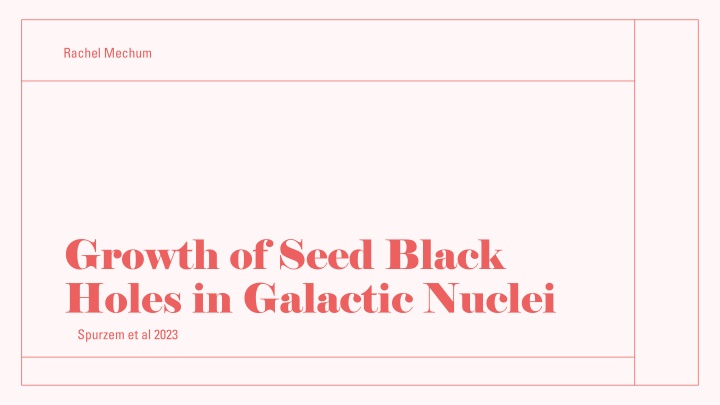
The Growth of Black Holes in Galactic Nuclei
Explore the evolution of dense star clusters, focusing on stellar populations, binary fractions, compact objects, and intermediate-mass black holes. Discover how theoretical models and relativistic dynamics play a crucial role in studying stellar evolution and the formation of black holes within the (P)PSN mass gap. Witness generational mergers involving black holes to gain insights into mass distribution and merger visualization within galactic nuclei.
Download Presentation

Please find below an Image/Link to download the presentation.
The content on the website is provided AS IS for your information and personal use only. It may not be sold, licensed, or shared on other websites without obtaining consent from the author. If you encounter any issues during the download, it is possible that the publisher has removed the file from their server.
You are allowed to download the files provided on this website for personal or commercial use, subject to the condition that they are used lawfully. All files are the property of their respective owners.
The content on the website is provided AS IS for your information and personal use only. It may not be sold, licensed, or shared on other websites without obtaining consent from the author.
E N D
Presentation Transcript
Rachel Mechum Growth of Seed Black Holes in Galactic Nuclei Spurzem et al 2023
We care because... Want to know the evolution of dense star clusters Want to know the evolution of dense star clusters (galactic GCs & NSCs) (galactic GCs & NSCs) Recent high-res imaging revealed more structural properties: Stellar populations, binary fractions, compact objects, & IMBHs Dense star clusters are the ideal lab for study of stellar evolution and dynamics BHs forming/evolving in these regions are the BHs forming/evolving in these regions are the most prominent source for GWs over all most prominent source for GWs over all frequencies! frequencies! 2 2 3 / 2 0 / 2 0 2 5 ESA/Hubble
What are they doing differently? ...than everyone else that studies stellar evolution Theoretical models: stellar BH's 30 M_sun GW150914 observed components more massive than 30 M_sun Use GW data to their advantage! Adapt precise models for stellar winds and pre-stellar collapse Include relativistic dynamics of compact objects 3 3 3 / 2 0 / 2 0 2 5
Addition of Stellar Models and Relativistic Dynamics Evolution of massive stars is important to understand mass distribution of stellar BHs at their formation At the onset of stellar collapse, stars with large He cores head towards an explosion Pulsation Pair Pulsation Pair- -Instability Supernovae = partially Instability Supernovae = partially destroyed destroyed Pair Pair- -Instability Supernovae = destroyed completely Instability Supernovae = destroyed completely Isolated massive stars collapse into BHs in the 50-130 M_sun mass range (45-195 M_sun in study) We now have what's called the (P)PSN mass gap! (P)PSN mass gap! Orbital averaged approach merger when orbital shrinking time < orbital time 4 4 Mass accretion parameter Mass accretion parameter f_c f_c 3 / 2 0 / 2 0 2 5
Generational Merger Visualization Gen-1 and Gen-2 mergers involving BHs Gen-3 2 preceding mergers involving BHs Gray region is a merger within Gray region is a merger within the mass gap the mass gap 5 5 3 / 2 0 / 2 0 2 5
Did they find IMBH formation within their simulations? Yes! IMBHs with masses up to ~ 350 M_sun form on timescales of order 15 Myr Final mass dependent on f_c (mass accretion) First time that such IMBH formation has been shown in N First time that such IMBH formation has been shown in N- -body simulations (quality and resolution) resolution) body simulations (quality and 6 6 3 / 2 0 / 2 0 2 5
Results of BH Mergers in Mass Gap LVK discovered GW190521 (within 95-150 M_sun mass gap) & four further mergers in IMBH mass range ( > 100 M_sun) Simulations report a development of GW190521-like system resulting from Gen-3 merger & four IMBH-BH mergers (M_tot = 300-350 M_sun) These IMBH-BH mergers will be detectable by future spaced-based GW detectors BH mergers occur in mass gap because they are a result of several generational mergers in star BH mergers occur in mass gap because they are a result of several generational mergers in star clusters clusters 7 7 3 / 2 0 / 2 0 2 5
Future possibility to constrain the physics of BH-stellar collisions Comparison of simulation and actual detected events from LVK f_c = 1 (no mass loss) provides two formation paths for GW190521 B B is a Gen-1 merger which is more likely f_c = 0 simulation generated an intermediate-mass ratio inspiral of two BHs A A with masses of 31 and 181 M_sun 8 8 3 / 2 0 / 2 0 2 5
Conclusions Dense star clusters contain multiple astrophysical processes Stellar evolution Formation of BHs Found growth of IMBHs Mergers occur within the PSN mass gap Such mergers have already been detected by LVK Provides greater likelihood to constrain collisions of BHs and stars 9 9 3 / 2 0 / 2 0 2 5
